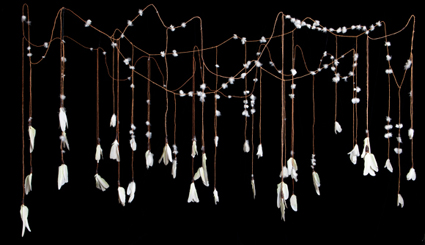I remember as a young girl, bending and stretching, in black leotard and mended tights, the running stitches looking like haphazard little black caterpillars. With my awkward arms and gangly legs, I was never going to be a graceful black swan. We filled the small hall, learning the rudiments of ballet and tap dance. I can still do the 'shuffle hop step, da da da da' though goodness knows what else went with it. At one end of year show, The Wizard of Oz, I was a munchkin in an icky pale green outfit with fabric daisies stuck on it. What an awful delight; a bunch of little girls in daisy suits. Perhaps we sang a munchkin song? I was more excited that Toto was played by a real dog. Small and white and fluffy. And it didn't pee on the stage.
This gives you an idea of our costumes. The photo was taken by Dad in 1966. I am in the second row, central in a red 'highland dance' costume. My sister is in the front row in a pale bluey green costume with the frilly hat. Delightful .... hmmmm.
This photo was taken at a Sing Sing at Kokoda in September 1970.
And the Papuans could sing. Singing from the 'cradle', or in their case the bilum, their voices were clear, confident and harmonious. It was a revelation and I loved that freedom of expression so apparent there and in boarding school. At boarding school we sang all the time. On the bus too and from school, everyday in the chapel, at choir practice and we just sang for the pure pleasure of it. I had the shock of my life when four years later we came back to WA and people just didn't break into song because they felt like it.
It was at boarding school some Port Moresby girls taught me a more complicated rolling of the feet dance movement. It was rather like tracing a circle on the ground with each foot. Your bent knees and hips followed your feet, swaying in circles. Add in some pretty arm movements, a skirt and some frangipani leis and you had a Papuan hula. But we were in an arid gold mining town, surrounded by mulloch heaps, chinky apples and a town nearby whose claim to fame was a gallows in the main street (morbidly fascinating to teenagers). So no frangipanis, just a few hardy hibiscus to put in our hair.
Sharon on the left was one of the girls who taught me the Papuan hula moves. It was 1972 let it all hang out peace man. Just for the record the red spot behind Sharon is an hibiscus flower.
Later on it was bush dances with the Mucky Duck Bush Band on Saturday nights. On the weekends when we weren't dancing we were in the bush camping and caving. Those were the days of cheap fuel. I think it cost about ten dollars for a weekend down south. Outside of work we lived for being in the bush, getting grotty, then swimming in a river or the ocean or trogging through an underground stream - or just staying grotty.
It was a big step from my early experiences to being part of the Songlines project last year, a community performance of Joey Williams' songlines from the Stirlings to Denmark. As part of our rehearsal process we had a morning down by the river swimming and dancing. We learnt about Joey's family stories that we were performing, a variety of types of fire, sparks, and smoke. Performing on stage was initially confronting but the nerves disappeared when concentrating on the dance. I am still not fluid but happy in being brave enough to have a go and I have learnt about the arts of concentration and transformation of ideas into movement. But the best part is a shared experience with other members of the community and having fun in the process.











